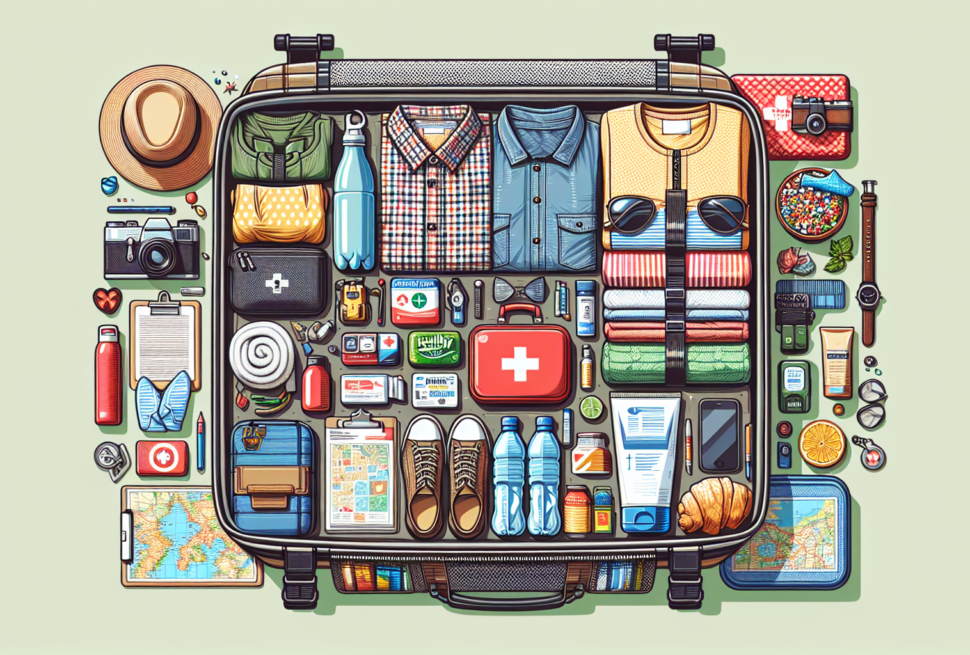Taking a road trip can be an exhilarating adventure, filled with beautiful scenery and unforgettable memories. However, it’s important to prioritize safety while embarking on your journey. From preparing your vehicle to staying alert behind the wheel, this article highlights essential tips to ensure a safe and enjoyable road trip experience. So buckle up, sit back, and get ready to hit the open road with confidence.
Choosing a Safe Vehicle
When embarking on a road trip, the first and most important step is to ensure that you are traveling in a safe vehicle. Regular vehicle maintenance is key to keeping your vehicle in top shape and preventing any unexpected breakdowns. It is crucial to schedule routine check-ups and oil changes to ensure that your vehicle is operating smoothly. Regularly inspecting your tires and brakes is also essential for your safety on the road.
In addition to vehicle maintenance, checking for recalls is essential. Keep track of any recalls that may affect your vehicle, and make sure to address them promptly. Recalls are issued when a safety issue or defect is discovered in a vehicle, and it is important to have these issues resolved by a certified technician to ensure your safety.
Inspecting Tires and Brakes
Before embarking on your road trip, it is crucial to inspect your tires and brakes. Tires should be properly inflated to the recommended pressure, as underinflated tires can affect handling and increase the risk of a blowout. Check the tread depth of your tires, as worn-out tires can reduce traction and increase the likelihood of hydroplaning on wet roads. Additionally, inspect the brake pads for any signs of wear and tear. Properly functioning brakes are essential for safe and reliable stopping power.
Securing Loose Objects
When on a road trip, it’s important to secure any loose objects in your vehicle. Loose objects can become dangerous projectiles in the event of sudden braking or an accident. Make sure to secure your luggage, electronics, and any other loose items properly. Consider using bungee cords, cargo nets, or organizers to keep everything in place.
Planning the Route
Before hitting the road, take the time to plan your route thoroughly. Utilize navigation apps or GPS devices to map out your journey and identify the most efficient and safest routes. Take into account the distance, traffic conditions, and potential road closures or construction areas. By planning your route ahead of time, you can save time, fuel, and reduce the likelihood of encountering unexpected hazards along the way.
Checking Weather Conditions
Weather conditions can significantly impact your road trip experience. Stay informed about the weather forecast for your route and destination. Keep an eye out for potential storms, heavy rain, snow, or foggy conditions. If adverse weather conditions are expected, consider adjusting your travel plans or taking alternative routes to ensure your safety on the road.
Packing an Emergency Kit
No road trip is complete without an emergency kit. Pack a kit that includes essential items such as a first aid kit, extra water, non-perishable snacks, blankets, roadside flares, a flashlight, and a fully charged mobile phone. In the event of an emergency or breakdown, having these items readily available can make a significant difference in staying safe and comfortable until help arrives.
Sharing Itinerary and Contact Information
Before setting off on your road trip, make sure to share your itinerary and contact information with a trusted friend or family member. Provide them with details of your intended route, planned stops, and estimated arrival times. This way, someone will be aware of your whereabouts and can alert authorities or initiate necessary action if you fail to check-in as scheduled.
Avoiding Fatigue
Driving long distances can be tiring, and fatigue can significantly impair your ability to drive safely. Avoid driving for extended periods without taking breaks. Make sure to get plenty of rest before embarking on your road trip and schedule regular stops to stretch your legs and rest your eyes. If you start feeling drowsy, find a safe place to pull over and rest.
Buckling Up and Adjusting Seat
Buckling up is a simple yet essential step to ensure your safety on the road. Before starting your journey, make sure all passengers are wearing their seat belts, and adjust your own seat to a comfortable and ergonomic position. Proper seat belt usage significantly reduces the risk of injury in the event of a collision, so it’s important to make it a habit.
Adhering to Traffic Laws
One of the most important aspects of driving safely is adhering to traffic laws. Obey speed limits, traffic signals, and road signs. Use your turn signals when changing lanes or making turns, and always yield to pedestrians and other drivers who have the right of way. By following traffic laws, you not only ensure your own safety but also contribute to the overall safety of the road.
Controlling Speed
Controlling your speed is crucial for safe driving. Always maintain a speed appropriate for the road and weather conditions. Reduce your speed in adverse weather or when driving on unfamiliar or winding roads. Remember that it’s better to arrive at your destination safely and slightly later than to risk an accident by rushing.
Using Turn Signals
Using your turn signals is not only a legal requirement but also an essential safety measure. Signaling your intentions allows other drivers to anticipate your next move and adjust accordingly, reducing the risk of collisions. Get into the habit of signaling well in advance, providing ample time for other drivers to respond to your maneuver.
Limiting Mobile Phone Use
Distracted driving is a leading cause of accidents. During your road trip, it is vital to limit the use of your mobile phone while driving. Avoid making or receiving phone calls, texting, or browsing the internet. If you need to use your phone, pull over to a safe location or use hands-free devices such as Bluetooth.
Avoiding Eating and Drinking While Driving
Eating or drinking while driving can be a significant distraction. Avoid consuming food or beverages while behind the wheel as it diverts your attention from the road. Instead, take breaks to enjoy your meals or snacks, or choose convenient pit stops along the way to satisfy your hunger or thirst.
Minimizing Passenger Distractions
Passengers can also contribute to distractions while driving. Encourage your passengers to remain calm and avoid engaging in activities that can divert your attention, such as loud conversations, unruly behavior, or excessive noise. Prioritize your focus on the road and ensure a safe and peaceful driving environment for everyone.
Taking Regular Breaks
Long hours of driving can take a toll on your concentration and focus. To combat fatigue, take regular breaks. Stop at rest areas or gas stations to stretch your legs, use the restroom, and take a short walk. These breaks will help you stay alert and refreshed throughout your road trip.
Using Rest Areas and Gas Stations for Quick Refreshments
Rest areas and gas stations are not just for refueling your vehicle. Take advantage of these stops to grab a quick snack, drink water, or have a cup of coffee to help you stay awake and alert during your journey. However, be mindful of the consumption of caffeinated beverages, as they can have varying effects on individuals.
Playing Music or Audiobooks to Stay Alert
Listening to music or engaging in audiobooks can help you stay alert and focused during long drives. Choose upbeat or engaging music that keeps you energized, or listen to an interesting audiobook that captures your attention. However, make sure the volume is at a safe level, allowing you to remain aware of your surroundings.
Driving in Rainy or Foggy Conditions
Driving in rainy or foggy conditions requires extra caution and attention. Reduce your speed and increase the distance between your vehicle and the one ahead of you. Use your headlights appropriately, and if visibility becomes severely limited, consider pulling over at a safe location until the weather conditions improve.
Navigating through Snow or Ice
Driving on snow or ice can be extremely hazardous. Before setting off in wintry conditions, make sure your vehicle is equipped with snow tires and chains if necessary. Drive slowly and gently, avoiding sudden acceleration, braking, or steering maneuvers. Maintain a safe following distance and allow extra time for braking.
Handling Strong Winds
When encountering strong winds, maintain a firm grip on the steering wheel and be prepared for sudden gusts that can push your vehicle. Reduce your speed, particularly on open highways or in areas prone to strong crosswinds. Be vigilant for obstacles or debris that strong winds may blow onto the road.
Maintaining Safe Distances
Maintaining a safe distance between your vehicle and the one ahead is crucial for safe driving. Adhere to the “two-second rule” by keeping a distance of at least two seconds from the vehicle in front of you. Increase this distance in adverse weather or road conditions, and be prepared to adjust as needed to ensure ample stopping distance.
Using Mirrors and Blind Spot Checks
Utilize your rearview and side mirrors effectively to stay aware of your surroundings. Regularly check your blind spots by glancing over your shoulder before changing lanes or making turns. This simple habit can prevent collisions with vehicles that may be lurking outside your field of vision.
Communicating with Hand Gestures or Horns
Clear communication with other drivers is essential on the road. Use hand gestures or your horn to communicate your intentions when necessary. However, it is important to use these methods judiciously and avoid aggressive or confrontational behavior. Maintain a respectful and courteous demeanor while interacting with other drivers.
Respecting Right of Way
Respecting the right of way is crucial for safe and orderly traffic flow. Yield when necessary and allow other drivers or pedestrians to proceed. Adhering to right-of-way rules not only prevents accidents but also fosters a harmonious and cooperative environment on the road.
Handling Tire Blowouts
A tire blowout can be a frightening experience, but staying calm is essential for your safety. Grip the steering wheel firmly, and steer your vehicle in a straight line while gradually reducing your speed. Do not slam on the brakes, as this can cause your vehicle to lose control. Once you have regained control, find a safe spot to pull over and change the tire or call for assistance.
Dealing with Engine Overheating
If you notice that your engine is overheating, it is important to act promptly to prevent further damage. Pull over to a safe location, turn off your engine, and allow it to cool down. Open the hood to facilitate air circulation. Once the engine has cooled, carefully check the coolant levels and refill if necessary. If the problem persists, seek professional assistance.
Reacting to Mechanical Failures
Mechanical failures can occur unexpectedly, but appropriate reactions can mitigate the consequences. If you experience a mechanical failure, turn on your hazard lights immediately and try to safely steer your vehicle off the road or to the shoulder. Activate your brakes and bring your vehicle to a stop. If possible, call for roadside assistance to help resolve the issue.
Contacting Roadside Assistance
Having the contact information for roadside assistance readily available can be a lifesaver during emergencies. Store the number in your phone, keep a physical copy in your vehicle’s glove compartment, or download a roadside assistance app. Whether it’s a flat tire, engine trouble, or a dead battery, having prompt and reliable assistance will ease the stress of unexpected breakdowns.
Being Cautious in Wildlife Areas
Many road trips take us through areas inhabited by wildlife. When driving through these areas, exercise caution and be prepared for unexpected encounters with animals. Observe posted speed limits and be vigilant for wildlife crossing signs. Slow down if you spot any animals near the road, and be prepared to stop if necessary.
Avoiding Sudden Movements or Honking
When encountering wildlife on the road, it’s crucial to avoid sudden movements or honking that could startle or agitate the animals. Sudden movements can cause animals to panic and potentially dart in front of your vehicle. Maintain a slow and steady pace, giving the animals ample time to safely cross the road.
Stopping Safely to Let Animals Pass
If you come across wildlife crossing the road, it is important to stop and allow them to pass safely. Stay inside your vehicle and maintain a safe distance from the animals. Resist the urge to approach or interact with them, as they may perceive it as a threat. Only proceed once the animals have safely moved away from the road.
Choosing Well-Lit and Populated Areas
When parking your vehicle, it is important to select well-lit and populated areas. Well-lit areas reduce the risk of break-ins, as they deter potential thieves. Populated areas provide an extra layer of security, as there are more likely to be witnesses to any suspicious activity. Choose parking lots near businesses or in busy areas whenever possible.
Using Parking Brakes
Always engage your parking brake when parking your vehicle, regardless of whether you are on a flat surface or an incline. The parking brake provides an additional level of security against your vehicle rolling unintentionally. By using the parking brake consistently, you can prevent accidents and ensure the safety of your vehicle.
Securing Valuables
Before leaving your vehicle, make sure to secure any valuables to minimize the risk of theft. Keep valuable items out of sight and locked in the trunk or glove compartment, or take them with you when you leave the vehicle. By preventing the visibility of valuable items, you reduce the temptation for potential thieves.
Locking Doors and Windows
Locking your vehicle’s doors and windows is a simple yet effective measure to enhance your safety and security. Always make it a habit to lock your vehicle whenever you exit, even if you are only stepping away for a brief moment. This prevents unauthorized access, reducing the risk of theft or intrusion.
By following these road trip safety tips, you can ensure a pleasant and secure journey on the open road. Remember that safety should always be a top priority, and taking proactive steps to maintain your vehicle, plan your trip, and drive responsibly will go a long way in keeping you and your passengers safe. Bon voyage!





